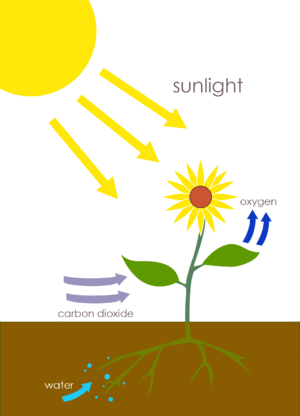
Photosynthesis refers to the process used by a plant to make use of the light energy caught by chlorophyll to turn carbon dioxide and water into food for the plant. In turn, the plant releases oxygen to the atmosphere, an atmospheric gas essential for respiration. Some other organisms, such as algae and cyanobacteria, also use photosynthesis.
The chemical energy created from photosynthesis is stored in carbohydrate molecules (sugars, starches). Glucose (C6H12O6) is then used by the plant or by animals, including humans, that consume the plant, for energy. The chemical formula for photosynthesis is: CO2 + H2O -> C6H12O6 + 02. In a nutshell, this means carbon dioxide + water = glucose and oxygen.
Photosynthesis occurs in two stages, the photosynthesis-light phase (limited to when daylight or simulated daylight is present) and photosynthesis-dark phase (at night or in darkness). The light energy usually comes from the Sun but it can also be simulated using artificial light, such as in a laboratory.
Photosynthesis is the basis of most energy needed to sustain all life on earth.[1] It is also an important part of atmospheric balance, contributing the the recycling of gases known as the oxygen cycle, by which oxygen and gases containing oxygen are exchanged between plants and animals.
The term "photosynthesis" is derived from Greek. Photo comes from the Greek φῶς, phōs, which refers to "light". Synthesis comes from the Greek σύνθεσις, which means "putting together".[1]
To test whether a plant has used photosynthesis, a starch test can be used. To see how oxygen is a by-product of synthesis, see further How to show oxygen is a by-product of photosynthesis.